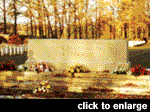





Netherlands Cemeteries |

 |
Arnhem (Oosterbeek) War Cemetery Arnhem (Oosterbeek) War Cemetery Arnhem is the capital of the Province of Gelderland; Oosterbeek is a village suburb about four miles from the city centre. It was in this area that the British 1st Airborne Division landed in September 1944 in their vain attempt to capture and hold the bridge over the Lower Rhine at Arnhem. The division made a stand within a gradually shrinking perimeter at Oosterbeek, holding out until all hope of relief by troops advancing from the south was abandoned and their supplies and ammunition ran out. Many of those who died were buried on the south side of Oosterbeek, in what was to become the cemetery when large numbers of others were brought in from temporary graves. The cemetery is the scene of an annual ceremony organized by the local people. It is also often visited by Poles, as a number of their countrymen are buried here. The cemetery contains over 1,600 British burials, over 30 Canadian, four each from Australia and New Zealand and 80 from Poland. There is an excellent museum nearby concerned with the fighting at Arnhem; it is owned and organized by the local authorities. |
The war cemetery is about 100 yards east of Bergen-op-Zoom Canadian War Cemetery. Many of those buried here died, like their Canadian brothers-in- arms, in the operations on the northern shore of the Scheldt Estuary in the latter months in 1944 and in south-west Netherlands thereafter. The cemetery contains 1,200 British burials, 45 Canadian, 12 Australian and 23 New Zealand. There are also a few British burials from WWI which were brought in when their original graves became unmaintainable. It is not clear why these two concentration cemeteries, so close to each other, were not constructed as one. |
Groesbeek Canadian War Cemetery Most of those buried here are Canadians who died in the heavy fighting in the battle of the Rhineland in February and March 1945. The cemetery is unusual in that many of the dead were brought here from nearby Germany -- one of the few cases where bodies were moved across international frontiers. So far as can be ascertained, all slain Canadian soldiers of the Rhineland battles, who were buried in German battlefields, were reinterred here (less one, who is buried in Reichswald Forest War Cemetery). General Crerar, who commanded Canadian land forces in Europe, ordered that Canadian dead were not to be buried in German soil. The cemetery contains the largest number of Canadians, 2,350, interred in the Netherlands and there are also 265 British burials. As it is the 'open' cemetery from the Netherlands, these figures are rising slowly. Canadian airmen who died in Germany and were buried there were not moved into Groesbeek, but into Commission cemeteries in that country. Back to the Top
|

| The text on this page has been taken from Courage Remembered, by Kingsley Ward and Major Edwin Gibson.
|
    
|


